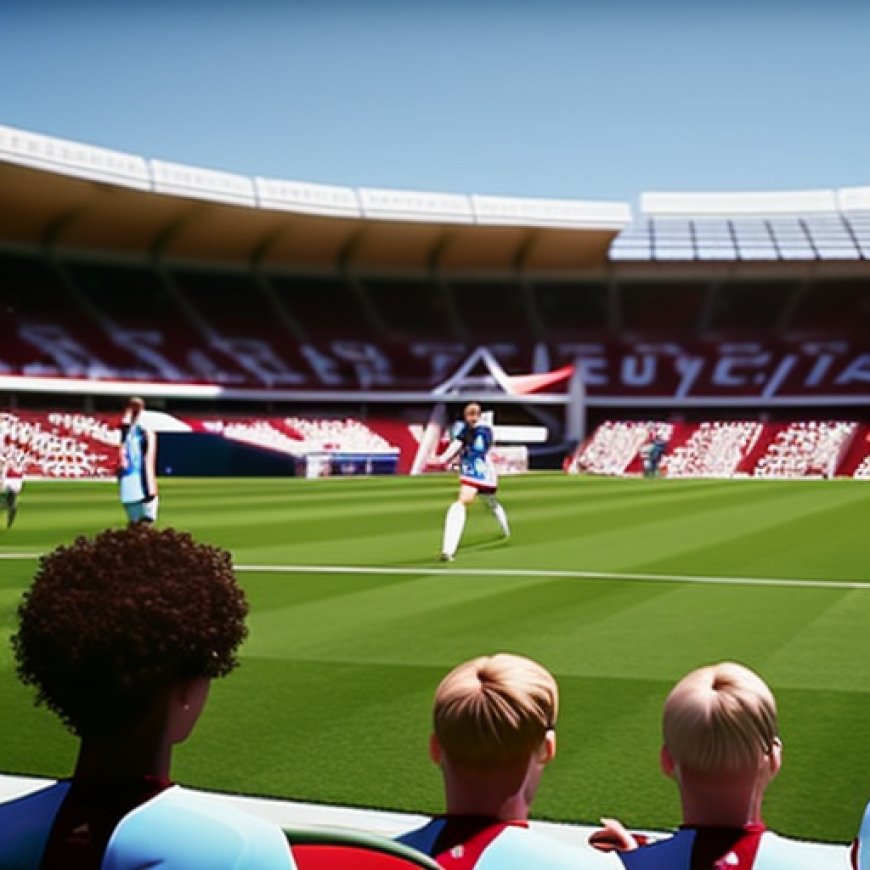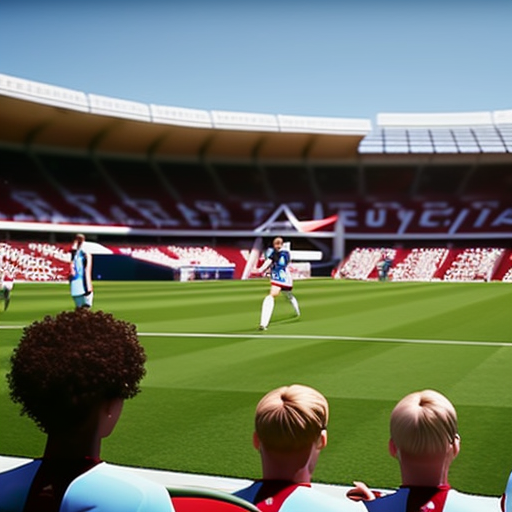Australia advances to Women’s World Cup quarterfinals by beating Denmark with Sam Kerr back
Australia advances to Women's World Cup quarterfinals by beating Denmark with Sam Kerr back ABC News


Australia Advances to Women’s World Cup Quarterfinals with Return of Sam Kerr

SYDNEY — Australia was already on course for the quarterfinals of the Women’s World Cup when Sam Kerr entered the field to wild celebrations on Monday.
With the star striker back from injury, the Matildas are confident contenders to win the tournament on home soil after beating Denmark 2-0 in the round of 16 at a raucous Stadium Australia.
“It’s a massive boost to have her back,” goal-scorer Caitlin Foord said. “For teams looking ahead it’s pretty scary to know she’s back in our team and she’s going to be a part of it with us.”
A crowd of 75,784 cheered as if Australia scored when Kerr was shown on the big screen preparing to come on. She had been sidelined since injuring her left calf on the eve of the tournament.
Despite that setback, Australia found a way to get by without her. But her return means the co-host can call on one of the best strikers in the world in a tournament that has seen holder the United States, Germany and Brazil eliminated before the quarterfinals.
Goals from Foord and Hayley Raso underlined the depth of the Matildas even without Kerr.
“The one thing I think has happened with this team is they were very tight and together when this tournament started,” Australia coach Tony Gustavsson said. “But the tournament, the experience, the challenges and the adversity they have come through have made them even tighter.”
Australia seems to be getting stronger after looking in danger of exiting in the first round from the tournament it is co-hosting with New Zealand. Gustavsson’s position was under scrutiny after losing to Nigeria.
The mood has become very different with belief spreading through the team and the fans, who created a daunting atmosphere for Denmark.
“It really felt like an away game,” Denmark coach Lars Sondergaard said.
Australia will face France or Morocco in Brisbane on Saturday when Kerr should be in contention to start for the first time at a World Cup she was expected to star in.
“We don’t need to look at her taking over and having everything on her shoulders,” Gustavsson said. “It’s a team effort and a team tournament.”
Still, Gustavsson considers Kerr’s return the icing on the cake for his team.
This is only the second time Australia has advanced to a World Cup quarterfinal, having previously done so in 2015.
Foord fired the Matildas in front in the 29th after running on to a pass from the impressive Mary Fowler. Then Raso drilled home a second in the 70th after Emily van Egmond’s lay off in the box.
“The match was decided by Australia’s effectiveness in front of goal and our not-so-efficient play in front of goal,” Sondergaard said. “We started the game best. Up until 1-0 we were the best team.”
Excitement ahead of the game could be felt around Sydney. Even the Opera House was lit up in the yellow and green colors of the Matildas.
Back in Stadium Australia where the team began its campaign on July 20, the Matildas were still too strong for Denmark without Kerr, who was on the bench.
Foord’s opener came after Fowler’s incisive pass from her own half. Foord raced forward and, cutting in from the left, slipped her shot between the legs of Denmark goalkeeper Lene Christensen to spark wild fan celebrations.
Foord was close to scoring a second before halftime when a shot across goal looped just past the post with Christensen beaten.
Van Egmond’s backheel from close range was then saved in the second half.
With the score still at 1-0, Gustavsson told Kerr to ready
SDGs, Targets, and Indicators in the Article
-
SDG 5: Gender Equality
- Target 5.1: End all forms of discrimination against all women and girls everywhere
- Indicator 5.1.1: Whether or not legal frameworks are in place to promote, enforce and monitor equality and non-discrimination on the basis of sex
-
SDG 10: Reduced Inequalities
- Target 10.2: By 2030, empower and promote the social, economic and political inclusion of all, irrespective of age, sex, disability, race, ethnicity, origin, religion or economic or other status
- Indicator 10.2.1: Proportion of people living below 50 percent of median income, by age, sex and persons with disabilities
-
SDG 16: Peace, Justice and Strong Institutions
- Target 16.7: Ensure responsive, inclusive, participatory and representative decision-making at all levels
- Indicator 16.7.1: Proportions of positions (by sex, age, persons with disabilities and population groups) in public institutions (national and local legislatures, public service and judiciary) compared to national distributions
Analysis of the Article
The article discusses the Women’s World Cup and the return of Sam Kerr, a star striker for the Australian team. Based on the content of the article, the following SDGs, targets, and indicators can be identified:
1. SDG 5: Gender Equality
The article highlights the participation of Sam Kerr, a female athlete, in the Women’s World Cup. This is connected to SDG 5, which aims to achieve gender equality and empower all women and girls. The return of Sam Kerr demonstrates the promotion of gender equality in sports.
- Target 5.1: End all forms of discrimination against all women and girls everywhere
- Indicator 5.1.1: Whether or not legal frameworks are in place to promote, enforce and monitor equality and non-discrimination on the basis of sex
2. SDG 10: Reduced Inequalities
The article mentions the inclusivity and diversity of the Australian team, highlighting their strength even without Sam Kerr. This connects to SDG 10, which aims to reduce inequalities and promote social, economic, and political inclusion for all individuals. The article emphasizes the team’s unity and the inclusion of players from different backgrounds.
- Target 10.2: By 2030, empower and promote the social, economic and political inclusion of all, irrespective of age, sex, disability, race, ethnicity, origin, religion or economic or other status
- Indicator 10.2.1: Proportion of people living below 50 percent of median income, by age, sex and persons with disabilities
3. SDG 16: Peace, Justice and Strong Institutions
The article mentions the decision-making process within the Australian team and their unity in facing challenges. This is connected to SDG 16, which aims to promote peaceful and inclusive societies and provide access to justice for all. The article highlights the team’s strong institutions and their ability to overcome adversity.
- Target 16.7: Ensure responsive, inclusive, participatory and representative decision-making at all levels
- Indicator 16.7.1: Proportions of positions (by sex, age, persons with disabilities and population groups) in public institutions (national and local legislatures, public service and judiciary) compared to national distributions
Table: SDGs, Targets, and Indicators
| SDGs | Targets | Indicators |
|---|---|---|
| SDG 5: Gender Equality | Target 5.1: End all forms of discrimination against all women and girls everywhere | Indicator 5.1.1: Whether or not legal frameworks are in place to promote, enforce and monitor equality and non-discrimination on the basis of sex |
| SDG 10: Reduced Inequalities | Target 10.2: By 2030, empower and promote the social, economic and political inclusion of all, irrespective of age, sex, disability, race, ethnicity, origin, religion or economic or other status | Indicator 10.2.1: Proportion of people living below 50 percent of median income, by age, sex and persons with disabilities |
| SDG 16: Peace, Justice and Strong Institutions | Target 16.7: Ensure responsive, inclusive, participatory and representative decision-making at all levels | Indicator 16.7.1: Proportions of positions (by sex, age, persons with disabilities and population groups) in public institutions (national and local legislatures, public service and judiciary) compared to national distributions |
Behold! This splendid article springs forth from the wellspring of knowledge, shaped by a wondrous proprietary AI technology that delved into a vast ocean of data, illuminating the path towards the Sustainable Development Goals. Remember that all rights are reserved by SDG Investors LLC, empowering us to champion progress together.
Source: abcnews.go.com

Join us, as fellow seekers of change, on a transformative journey at https://sdgtalks.ai/welcome, where you can become a member and actively contribute to shaping a brighter future.







